
NOW Articles Written By Members
An Argument for Collecting Half Dollars
Late Night and a Russian Type Set
Old Country Coins: Newfoundland’s Rarest 5-Cent
Milwaukee Medals: Fifth Ward Constable
A look back at a common, but classic commemorative – Wisconsin’s Territorial Centennial
A side-tracked story: Mardi Gras Doubloons
A look back at a collecting specialty – the O.P.A. ration tokens of WWII
Bullion And Coin Tax Exemption – Act Now!
Is There A Twenty Cent Piece We Can Add To A Collection
Capped Bust Half Dollars: A Numismatic Legacy
U.S. Innovation Dollars: Our Most Under-Collected Coin?
My 2023 ANA Summer Seminar Adventure
>> More articles in the Archive
For more NOW Articles Written By Members,
The Kewaunee Line Encased Coin Folder
Published by Leyse Aluminum Company
[By Don Kocken #2133]
The Leyse Aluminum Company of Kewaunee, Wisconsin started 119 years ago on April 1, 1903, then called The Aluminum Sign Company, at Two Rivers, Wisconsin, about 25 miles south of Kewaunee on the west bank of the East Twin River.
In 1978, Leyse Aluminum Company celebrated its 75th anniversary, by then their products were sold to all 50 states and Canada. They had 43 salespersons selling their products, 34 of them dedicated to institutions, restaurants, and hospitals.
Back in 1969, I drove a semi-truck for Schmidt's Discount Store in Green Bay, Wisconsin and they expanded with stores in Neenah and Janesville, with a rented warehouse from H.J Martin on Western Ave. in Green Bay. There were many times I would stop at companies along the shores of Lake Michigan, picking up backhauls from Chicago, Ill. to Algoma, WI. One such company was Leyse Aluminum Company. Recently, I obtained an encased coin folder called ‘THE KEWAUNEE LINE’ and started my research with some of the people in Kewaunee, WI.
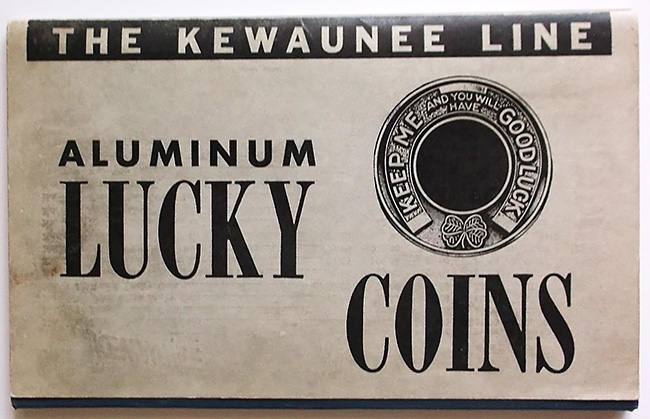
Over several months I met with Ron Opicka, John Berner, and John Schultz. Each provided me with pertinent information about the Leyse company. Ron oversaw the Kewaunee County Development Center, a service that helps developmentally disabled individuals achieve work skills. They installed key chains on the Lucky encased coins made by Leyse Aluminum Company. John Schultz is a semi-retired businessman who devotes much of his time to the Kewaunee County Historical Society, he gave me a tour of all the Leyse buildings and showed me newspaper items. John Berner was the general manager in later years for the Cookware Department.
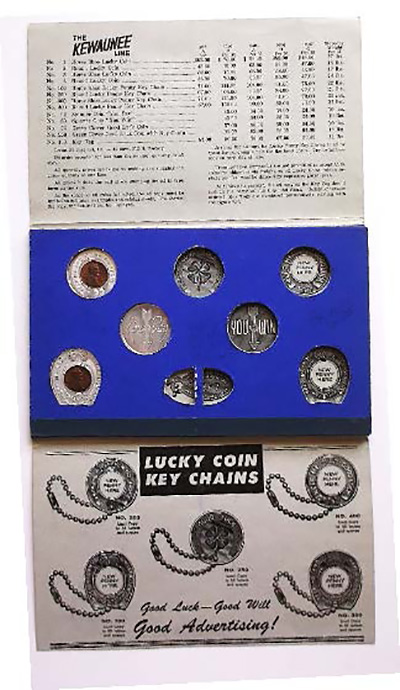
I cannot provide the documented proof I sought to determine exactly when the THE KEWAUNEE LINE Aluminum Lucky Coin Folder was created for Lucky Coins [more commonly called encased coins,] Spinners and Key Tags. These are salesmen’s sample folders containing generic samples of encased coins. Today this is a rare and important historical artifact that documents the origin and ordering protocol for many Wisconsin encased coins. Leyse produced most of the encased coins of Wisconsin.
The grey and black encased coin folder was made of cardstock measuring 9 inches by 5 3/4 inches with an enlarged encased coin on the front. The folder opens flat to display the generic samples. The inside front cover gives information on the quantity, cost, and terms of ordering the samples.
The next page is extra thick blue cardstock with pictures inside the portholes of the samples they sell. Also Inside of the folder, there is a dark grey extra thick page with portholes cut the size of samples. The inside back cover shows pictures of Lucky Coin Key Chains.
The folder contained eight encased samples designated as No. 1 through 4 and No. 100 through 400. A few other non-encased samples such as spinners and tags were included as well.
Today, the individual encasements No. 1 through 4 are COMMON and worth about $7. No. 100 through 400 are SCARCE and worth about $10. There are numerous letter placement varieties of the eight basic types. The original folder is very RARE. Recently two of these salesman folders came up on eBay and sold for over $300 each, which begs the question; how many of these folders were made?
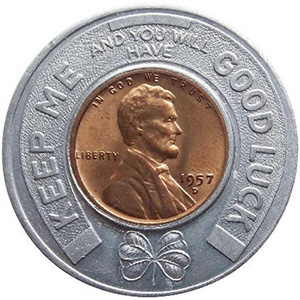
What is an encased coin? It's a coin [usually a cent] that has a ring clenched around it usually made of aluminum, but sometimes other materials were used. One side of the aluminum ring usually has a good luck horseshoe with the words "KEEP ME AND NEVER GO BROKE" or " KEEP ME AND HAVE GOOD LUCK" on it. The other side would have whatever inscription you wanted, such as place of business, advertisement, or a message. Encased coins were made 500 to 1000 peices or more at a time on large coining presses using engraved dies. A blank aluminum ring, like a washer, would be put in the press, and a coin set in the middle. The pressure used to stamp the message into the aluminum ring also caused the ring to clench the coin tightly.
Company History
Albert Leyse was born Sept. 7, 1872, at Mason City, Iowa of Norwegian parents. He and his brother Norman, who was 10 years his junior, produced printed aluminum advertising novelties, signs, calendars, combs, and other aluminum novelties out of a two-story frame building.
Equipment at the start consisted of a hand fed platen printing press, one punch press, a square shear, and a shaper. There were rumors that some of the equipment was obtained from the Denver Mint, but I could not find any evidence of this. Albert soon picked up sufficient knowledge and experience to be the tool and die maker. Norman was the sales manager and ran the shipping department and printing press. Their first employee, Jule Neumann, ran the punch press, who later became their plant Superintendent for 37 years. Two girls were employed the following year and as the Company began its third year, it was obvious they would soon need to expand.
About this time, the City Council of Kewaunee convinced the Leyse brothers to bring their new industry to Kewaunee. The proposal included a modern two story 40 x 60-foot building with free land, fifty feet from the lake front of Lake Michigan, to be deeded to the brothers when the company's payroll totaled $25,000.
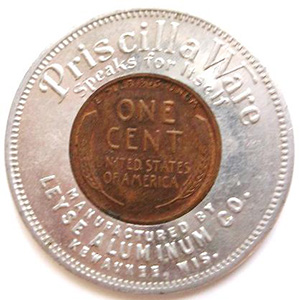
On May 20, 1905, the lake steamer Ottowa delivered the entire operation, including: 25 workmen and their families, machinery, equipment, 2 dogs and 1 cat. Albert Leyse first official act in Kewaunee was to borrow $40.00 from the Kewaunee State Bank to pay the ship's captain so his employees and equipment could be released from the ship. A week after arrival, the machinery in the new plant was ready to roll and on the first day 13 people were employed. Two other brothers joined in the earlier days and followed the company to Kewaunee; John Leyse who took charge of the printing department, and Henry Leyse who oversaw the tool and die department.
The company enjoyed steady growth in printed aluminum advertising novelties such as encased coin holders, spinners, lucky coin key chains and tags, and in 1919 a major expansion took place and the company's name changed to Leyse Aluminum Company, and at the same time the company capitalization was increased through the sale of common and preferred stock.
In 1926, another venture was undertaken with the manufacturing of decorated metal parts for dial faces for clocks and aluminum cookware and utensils. The aluminum ware line was succeeded later by a somewhat lighter gauge line and marketed as Priscilla Ware. Trademark registration 8-11-1931, Aluminum Kitchen & Serving Utensils. By 1938 the plant had been expanded to 35,000 square feet and 90 employees.

Priscilla Ware advertising placard and lunch box.
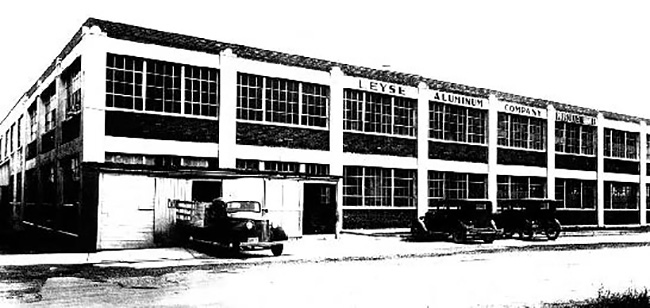
Leyse Aluminum Company / Priscilla Ware. Ca.1938
Then came World War II and new restrictions on the use of aluminum. Production dropped off for the entire cooking utensil industry. Employment was down to 35 people. Very few advertising novelties were produced at this time. The plant was turned over to war production for the Quartermaster Department making various items such as manufacturing of over 4,000,000 stainless steel mess kits and kitchen equipment which brought new life to the plant. Soon the presses were punching out military kitchen ware, as well as filter tanks and other parts for aircraft. The famed P-47 fighter planes were all equipped with Leyse hydraulic reservoirs.
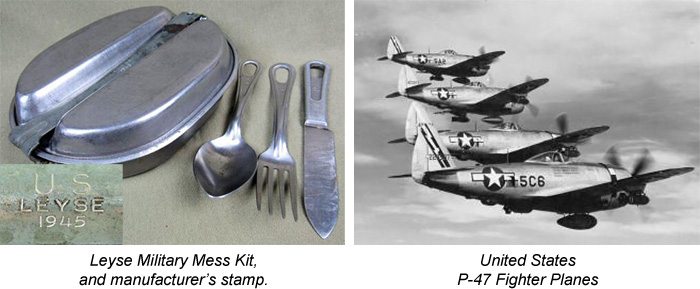
In 1949 Albert Leyse resigned as president, due to illness, turning the office over to his younger brother Norman.
The Korean War brought a new government contract for aircraft parts. In 1953, greater emphasis was placed on producing decorated metal products and aluminum and stainless-steel parts for the radio, television and appliance industries and special coins.
In 1954 Norman Leyse retired and his son-in-law Paul J. Mutchow became president. Additions were added in 1945, 1948, 1951, 1956, 1965 and 1966 totaling 200,000 square feet. The advertising novelty line of encased coins, spinners and tags began a slow decline in the mid-60’s. By then the firm employed 235 people.
Product lines expanded to include a commercial cookware line marketed as Toroware. The Advertising Novelty Line was down to primarily special coins. Diverse product line growth continued during the 60's and 70’s.
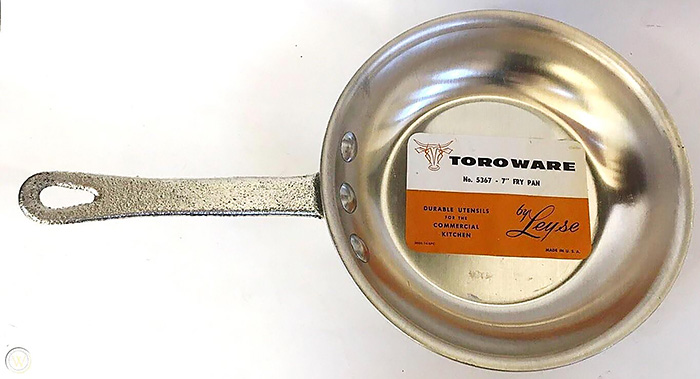
Toroware by Leyse. Fry pan. Ca.1969
In 1983, General Housewares Corp. from Terra Haute, Indiana, purchased Leyse Aluminum Company, which marked the beginning of the new era. All manufacturing capabilities have been upgraded to faster service and improved quality to help provide the continued growth of Industrial sales in Kewaunee, Wi.
Factory offices and the personnel department are still located on the lake front, but most of the offices are located at 203 Ellis St. which is State Hwy 29 - dead end on the left side at Lake Michigan. The last building built was in 1966 for shipping and finished goods, located on 15 acres on top of the hill in the northwest area of Kewaunee, WI.
As an update, General Houeswares Corp. was purchased on December 29, 1989, by the Vollrath Company of Sheboygan, Wisconsin. The Vollrath plant in Sheboygan is one of the largest producers of commercial stainless-steel cookware in the United States. With the addition of the former Leyse plant, they plan on being the largest supplier of stainless and aluminum cookware in the commercial marketplace. Over many years it has been a good and interesting marriage of product lines. From humble beginnings with ENCASED COINS and NOVELTIES, to COOKWARE, MILITARY SUPPLIES, AIRCRAFT PARTS and more!

Sources:
Kewaunee County Historical Society: The leyse Aluminum Company, with help of John Schultz
https://www.wdfi.org/apps/CorpSearch/... Registry Page opencorporates.
Earl Fankhauser on "What is an encased coin"
John P. Berner, agent for Leyse Aluminum Company
THE ENCASED COINS OF WISCONSIN by James Skwarek
Ron Opicka, Kewaunee County Development Center
Have an interesting numismatic topic you’d like to share with your fellow NOW members?
Send your article to evan.pretzer@protonmail.com today!!!